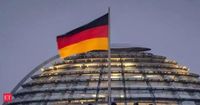Germany, long regarded as the economic powerhouse of Europe, has found itself in the throes of a deepening economic contraction. The latest data, released by the Federal Statistical Office and widely reported by outlets such as The Economic Times, AINVEST, and MT Newswires, paints a sobering picture: the country’s gross domestic product (GDP) shrank by 0.3% in the second quarter of 2025, a figure that’s not only worse than the initial estimate of -0.1% but also signals a potentially historic third consecutive year of recession.
For a nation that has long prided itself on industrial might and export prowess, this downturn is more than a blip. According to the Federal Statistical Office, “industrial production, in particular, performed worse than initially assumed.” The numbers back up the sentiment: industrial output dropped by 1.9% in June alone, with machinery and steel orders collapsing by a staggering 7.8%. These declines come on the heels of a brief uptick at the start of 2025, when German businesses raced to fulfill orders before the imposition of new U.S. tariffs.
The impact of those tariffs cannot be overstated. The United States, under President Trump, slapped a 15% duty on most European goods, a 25% tariff on autos, and up to 200% on pharmaceuticals. With 10% of Germany’s exports destined for the U.S., the consequences have been swift and severe. ING economist Carsten Brzeski summed it up succinctly, telling AINVEST, “Recent corporate results were already a painful reminder that US tariffs, but also structural transitions, were in full swing in the second quarter, weighing on company results. This is a trend that won't change too much in the third quarter, with US tariffs of 15% on most European goods and uncertainty over whether (and when) the 27.5% tariffs on automotives will be brought back to 15%.”
The automotive sector, which accounts for 8% of Germany’s GDP, is particularly vulnerable. Analysts warn that if tariffs escalate, the sector could see a 6% loss in value added. The uncertainty is compounded by the July 2025 EU-U.S. trade deal, which, while providing some clarity with baseline tariffs, left key questions unresolved—especially regarding automotive and pharmaceutical carve-outs. As a result, German exporters remain in a state of limbo, unsure whether relief is on the horizon or more pain awaits.
It’s not just exports and manufacturing that are feeling the strain. Household consumption, a key engine of domestic growth, was revised downward to a meager 0.1% increase in the second quarter. This adjustment came after fresh data from the services sector—especially accommodation and food services for June—revealed weaker-than-expected demand. Meanwhile, investments dropped significantly, with fixed capital formation in construction and equipment falling by 1.4%. The construction sector and net exports also registered declines, further dampening the economic outlook.
Yet, amid the gloom, there are flickers of resilience. Government spending increased by 0.8% on the previous quarter, and Berlin has responded to the crisis with bold fiscal measures. In 2025, Germany approved a constitutional amendment to its so-called “debt brake” rule, allowing defense spending above 1% of GDP to sidestep borrowing limits. More strikingly, the government established a €500 billion extrabudgetary fund for infrastructure, targeting semiconductors, green energy, and logistics—a clear signal of intent to modernize and future-proof the economy.
For investors, the crisis is as much an opportunity as it is a challenge. AINVEST notes that defensive sectors like utilities and healthcare are emerging as safe havens. Companies such as RWE AG and Enel stand to benefit from the ongoing energy transition, while healthcare firms like B. Braun Melsungen AG are relatively insulated from export shocks. The infrastructure push is also expected to buoy firms in renewable energy (think Siemens Gamesa Renewable Energy and BayWa AG), logistics (DB Schenker), and semiconductors (Infineon Technologies).
Still, the path to stabilization is riddled with hurdles. Elevated energy prices and the costs of transitioning to renewables have strained energy-intensive industries. The euro’s 12% rise against the dollar in 2025 has further eroded export competitiveness. And while the European Central Bank is expected to cut interest rates in 2026—a move that could spur growth in capital-intensive sectors—bureaucratic delays in green energy project approvals remain a significant bottleneck. Companies with streamlined permitting processes, such as Next Kraftwerke AG, may have an edge, but many others are left waiting in the wings.
Despite the contraction, there are signs that the worst may not last forever. S&P Global’s August 2025 Purchasing Managers’ Index (PMI) data showed that business activity in Germany rose for the third straight month, with growth reaching its fastest pace since March. While the increase remains modest, it suggests a glimmer of underlying strength—or at least a refusal to surrender to the gloom. Some analysts believe this optimism might be tied to the government’s fiscal stimulus or a bullish interpretation of the evolving trade landscape.
That said, the structural challenges are formidable. As AINVEST points out, “Germany's economic contraction is a short-term pain point but a long-term opportunity. Defensive sectors and infrastructure plays offer resilience amid uncertainty, while the EU-U.S. trade deal's implementation could unlock growth in 2026.” The key, experts say, will be balancing short-term hedging with long-term structural bets—positioning for eventual stabilization while weathering the current storm.
Looking at the broader picture, annual GDP growth in Germany was just 0.2% in the second quarter, down from 0.3% in the first. The prospect of three straight years of recession is unprecedented in the post-war era. Yet, even as the country grapples with production slumps, tariff headwinds, and the costs of transformation, the government’s willingness to adapt—whether through fiscal stimulus, infrastructure investment, or trade negotiations—offers a blueprint for eventual recovery.
For now, though, the message is clear: Germany’s economic engine has hit a rough patch, and the road ahead will require both resilience and reinvention. As the government, businesses, and investors chart their next moves, the global economy will be watching closely—wondering not just how Germany will recover, but what its journey might mean for Europe and the world.

